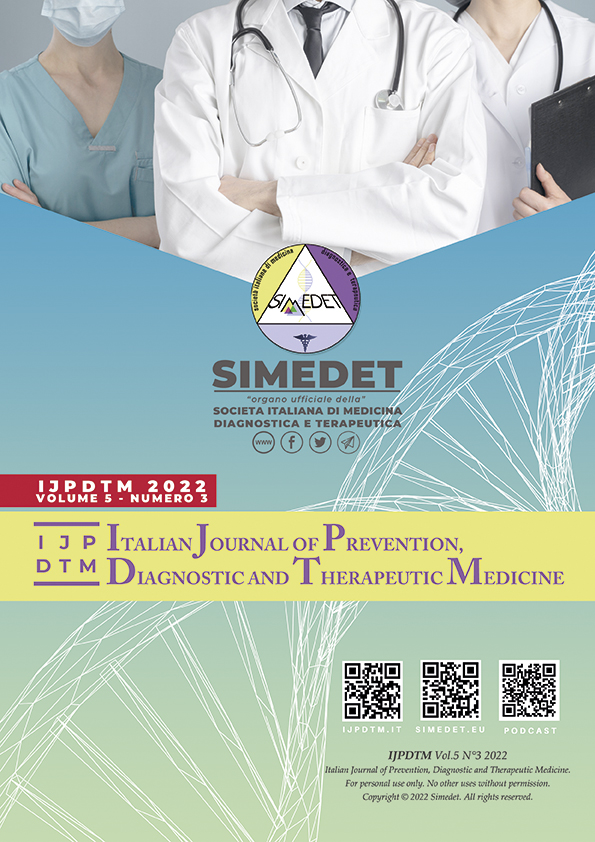The reorganization of the "Corelab" area of ASST Pope John XXIII in Bergamo between technological innovation and process re-engineering
Main Article Content
Abstract
PURPOSE
The theoretical context in which this work fits is the analysis and evaluation of the impact of the technological-organizational renewal of the “Corelab” Area of Analysis Laboratory of the ASST Papa Giovanni XXIII in Bergamo.
MATERIALS AND METHODS
The Area called "Corelab" is one of the three Diagnostic Areas of the Complex Operating Unit "Laboratory Medicine Service 2 - Clinical Chemical Analysis". In 2017, we began to think, as the date of the renewal of the tender in service approaches, to review the organization of this Area and the Preanalytical Phase of the Laboratory. The work therefore focused not only on the design and management of the new automation but above all on redesigning the main process (Pre-Analytical, Analytical and Post-Analytical Phases) and the support processes such as that of procurement with a broad-spectrum vision. in order to obtain a valid and usable tool even in highly variable environments such as those that characterize modern systems.
RESULTS
The new "Corelab", active since June 2019, is a highly automated system for the check-in, pre-treatment, sorting, aliquoting and storage of samples relating to the Analysis Laboratory. It performs Biochemistry, Immunochemistry, Pharmacology, Toxicology, Haematology, Coagulation and Blood Gas-analysis tests on whole blood, plasma, serum, urine and biological fluids both in emergency and routine conditions for hospitalized and external patients. The Pre-Analytical and Post-Analytical phases are managed by the integrated system "Aptio Automation" (Siemens) while the Analytical Phase is managed for the Biochemistry and Immunometry tests by the Atellica (Siemens) systems, for the Coagulation by the CS-5100 equipment (Siemens), for blood counts from the XN system (Sysmex), for Toxicology and Pharmacology from EXL equipment (Siemens) and for Blood Gas Analyzers from Rapid Point 500 (Siemens). Two Liaison analyzers (Medical Systems) have recently been integrated into the automation system for the determination of special Immunometry tests.
CONCLUSIONS
The project, created for the automated management of the entire diagnostic process, has proved to be a valid tool for product and process control. The integration of the Preanalytical Phase made it possible to manage a total of about 6,000 tubes per day and that of the Analytical Phase the execution of about 70% of the 4,500,000 / year laboratory tests. Particular attention, first in the design phase and then in the management phase, was reserved for the processes where many errors occur. The Analytical Phase involved an important rationalization of the activities, an enhancement of the professional figures involved while the re-engineering of the Post-analytical Phase allowed a rational management of the samples analysed and / or to be analysed.
Downloads
Article Details

This work is licensed under a Creative Commons Attribution-NonCommercial-NoDerivatives 4.0 International License.
References
-Forsman RW. Why is the laboratory an afterthought for managed care organizations? Clin Chem 1996; 42:813–6.
-Cappelletti, Piero. (2007). La Medicina di Laboratorio ed il miglioramento delle cure: un servizio essenziale, una prospettiva interdisciplinare, una visione olistica. La Rivista Italiana di Medicina di Laboratorio. 3. 19-24.
-Cappelletti, P. PDTA e Medicina di Laboratorio. Riv Ital Med Lab 13, 65–71 (2017)
-Direzione Generale Programmazione Sanitaria, livelli di assistenza e principi etici di sistema Linee di Indirizzo per la Riorganizzazione dei Servizi di Medicina di Laboratorio nel Servizio Sanitario Nazionale pag.5. Anno 2009
-The "hospital central laboratory": automation, integration and clinical usefulness. Zaninotto M, Plebani M. Clin Chem Lab Med. 2010 Jul;48(7):911-7. doi: 10.1515/CCLM.2010.192.
-Hawker CD. Laboratory automation: total and subtotal. ClinLab Med 2007;27:749–70.
-Bara, B.G. (2007). Dinamica del cambiamento e del non cambiamento. Bollati Boringhieri. Torino.
-Dahlgaard JJ, Dahlgaard SMP (2001) Lean production, six sigma quality, TQM and company culture—a critical review. In: Conference proceedings from the international Shanghai quality symposium, November
-Advantages and limitations of total laboratory automation: a personal overview. Lippi G, Da Rin G. Clin Chem Lab Med. 2019 May 27;57(6):802-811. doi: 10.1515/cclm-2018-1323.
o-Integration of Diagnostic Microbiology in a Model of Total Laboratory Automation. Da Rin G, Zoppelletto M, Lippi G. Lab Med. 2016 Feb;47(1):73-82. doi: 10.1093/labmed/lmv007. Epub 2015 Dec 29.
-Napolitano G, Farci Santarcangeli D, Fierro A. (2019). Il prelievo venoso: i principali errori preanalitici che influiscono sulla validità dei risultati di laboratorio. 10.30459/2019-9.
-http://www.asstpg23.it/upload/Trasparenza/2017/12/07/Organigramma_POAS_%202017.pdf (Data di consultazione: 24/09/2020)
-http://www.qualitologia.it/doc/doc_id466_idcat22.pdf - pag.2 (Data di consultazione: 11/10/2020)
-https://www.siemens-healthineers.com/it/integrated-chemistry/systems/atellica-solution-analyzers (Data di consultazione: 22/11/2020)

